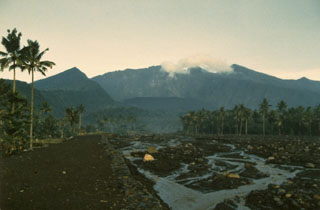Report on Galunggung (Indonesia) — April 1982
Scientific Event Alert Network Bulletin, vol. 7, no. 4 (April 1982)
Managing Editor: Lindsay McClelland.
Galunggung (Indonesia) Explosions and pyroclastic flows
Please cite this report as:
Global Volcanism Program, 1982. Report on Galunggung (Indonesia) (McClelland, L., ed.). Scientific Event Alert Network Bulletin, 7:4. Smithsonian Institution. https://doi.org/10.5479/si.GVP.SEAN198204-263140
Galunggung
Indonesia
7.25°S, 108.058°E; summit elev. 2168 m
All times are local (unless otherwise noted)
After 64 years of quiescence, a series of explosions . . . began 5 April. The most recent of these, which are reported to have claimed 30 lives, occurred the night of 17 May and at 1600 on 18 May. There is no permanent observatory at the volcano, but seismic monitoring has been conducted there for three months of every year since 1976. No significant seismic activity was recorded during the last monitoring period, September-November 1981.
Residents of villages 3 km from the summit felt an earthquake about 2200 on 4 April. At midnight, subsurface rumbling was heard, followed by emission of thick white fume. Detonations began at about 0200 on 5 April, and at 0400 a larger explosion ejected a black cloud. Explosive activity continued until about 1600, depositing ash on Bandung (population more than 1 million), 65 km to the NW. Persons living near the volcano fled the activity. The next day, VSI recommended to local officials that the SE flank remain evacuated within 6 km of the summit, but other residents could return to their homes.
An explosion at 2108 on 8 April, 23 minutes after a M 3.8 felt earthquake, was described by VSI on 1 May as the main eruption of the series. No local earthquakes had been reported since 6 April. A pyroclastic flow traveled 5 km from the crater down a SE flank river valley (the Cibanjaran), destroying small villages in the evacuated zone. Large volcanic ejecta killed three people 7 km from the volcano and ash fell as far as 23 km away. After this explosion, both eruptive and seismic activity ceased for several days. Earthquakes resumed 11 April. The number of events varied, but magnitudes and total energy release increased. Based on the seismicity, residents were warned 20 April of the danger of more eruptions.
Local newspapers reported moderate explosions 20 April. A thick black and white cloud ejected at 0808 rose ~ 2 km. Louder explosions at 0815 were followed by the ejection of a dense black cloud. Ash fell on nearby villages. At 0850 explosions were occurring every 15 seconds. By late afternoon six explosive episodes had been detected from nearby villages and rain mixed with ash was falling. Small eruption columns were observed 21-22 April. In accordance with VSI recommendations construction of dams to protect inhabited areas from lahars had begun by mid-April.
Renewed explosive activity began 25 April at 0455. A pyroclastic flow again moved down the Cibanjaran River valley, reaching 4.7 km from the crater. Tephra fell to the E and SE, with lapilli falling about 7 km away. As of 30 April, no additional eruptions had occurred, but VSI expected activity to resume within a few days. AFP reported that an explosion occurred 6 May at 0105. Ash fell 160 km away and two people were injured by hot tephra in Garut. On 17 May hot tephra showered the town of Tasikmalaya (17 km ESE) and injured four people; on the 18th, 2 cm of tephra accumulated there.
Geological Summary. The forested slopes of Galunggung in western Java SE of Bandung are cut by a 2-km-wide collapse scarp open towards the ESE. The "Ten Thousand Hills of Tasikmalaya" dotting the plain below the volcano are debris-avalanche hummocks from the collapse about 4,200 years ago. An eruption in 1822 produced pyroclastic flows and lahars that killed over 4,000 people. A series of major explosive eruptions starting in April 1982 destroyed a number of villages, killed as many as 30 people, and forced over 60,000 to evacuate. Pyroclastic flows and heavy widespread ash caused significant damage. A large passenger jet that encountered the ash plume on 24 June lost power to all four engines but managed to land safely in Jakarta. The 1982 activity destroyed a 1918 dome and formed the Warirang crater, almost as wide as the valley, about 2 km down from the summit.
Information Contacts: VSI; M. Krafft, Cernay; Jakarta DRS; Kompas and Sinar Harapan, Jakarta; AFP.

